Nursing Assignment on Impact of Colonization on Aboriginal People
VerifiedAdded on 2023/03/31
|6
|1226
|209
AI Summary
This nursing assignment explores the profound effects of colonization on the lives of Aboriginal people, including loss of land, culture, and physical and mental health issues. It also discusses ways in which clinicians can practice culturally safe care and highlights differences between Western and Aboriginal law.
Contribute Materials
Your contribution can guide someone’s learning journey. Share your
documents today.
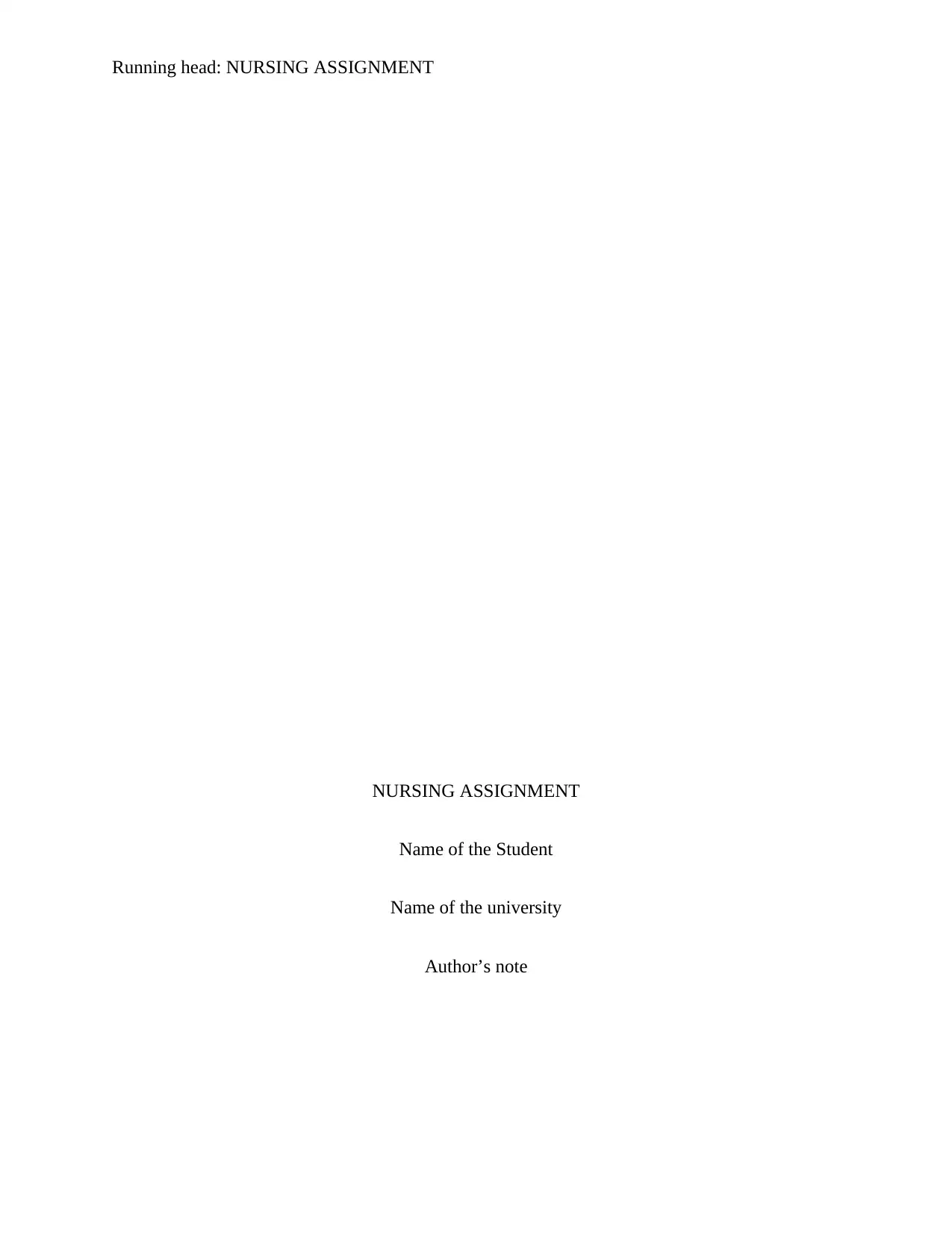
Running head: NURSING ASSIGNMENT
NURSING ASSIGNMENT
Name of the Student
Name of the university
Author’s note
NURSING ASSIGNMENT
Name of the Student
Name of the university
Author’s note
Secure Best Marks with AI Grader
Need help grading? Try our AI Grader for instant feedback on your assignments.
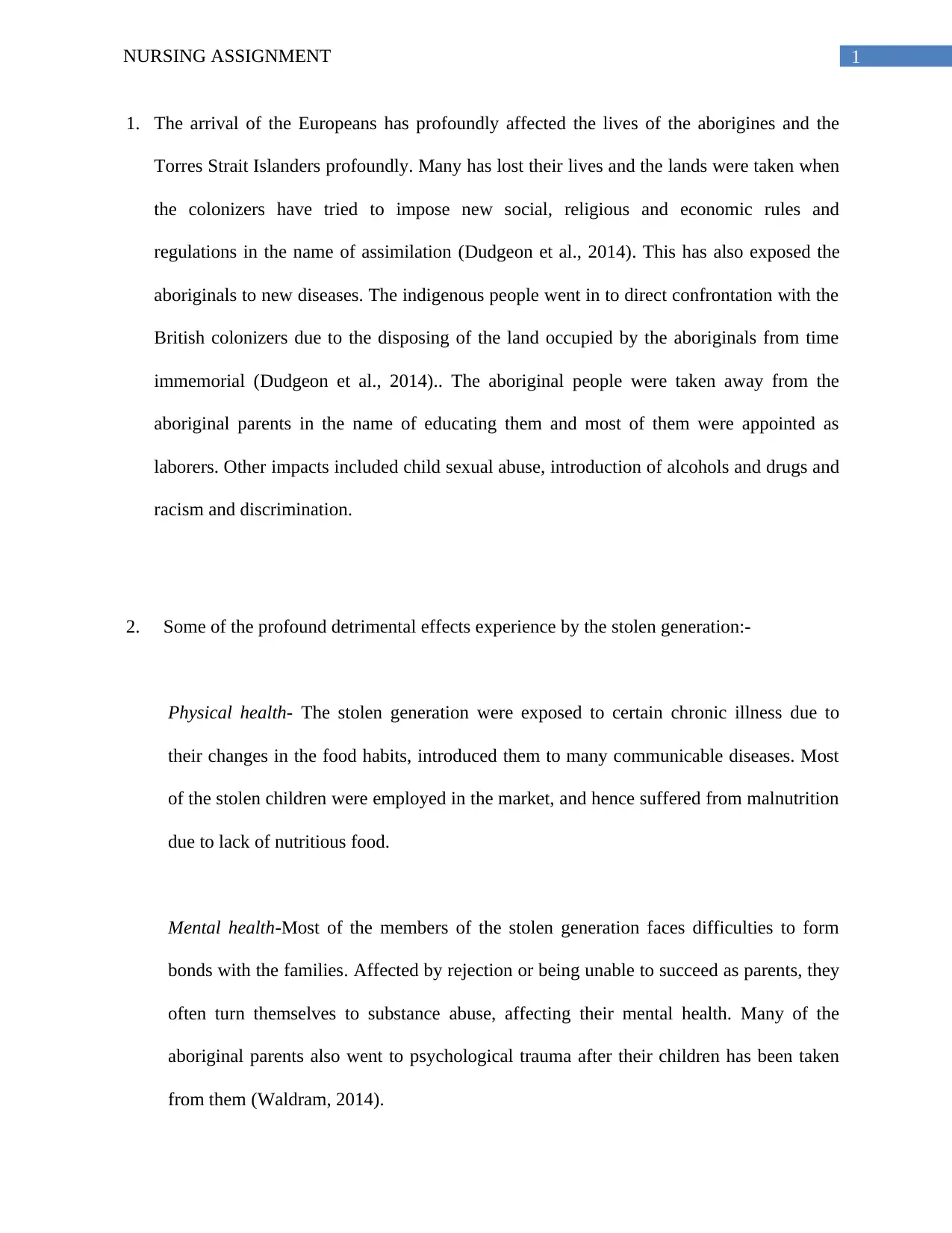
1NURSING ASSIGNMENT
1. The arrival of the Europeans has profoundly affected the lives of the aborigines and the
Torres Strait Islanders profoundly. Many has lost their lives and the lands were taken when
the colonizers have tried to impose new social, religious and economic rules and
regulations in the name of assimilation (Dudgeon et al., 2014). This has also exposed the
aboriginals to new diseases. The indigenous people went in to direct confrontation with the
British colonizers due to the disposing of the land occupied by the aboriginals from time
immemorial (Dudgeon et al., 2014).. The aboriginal people were taken away from the
aboriginal parents in the name of educating them and most of them were appointed as
laborers. Other impacts included child sexual abuse, introduction of alcohols and drugs and
racism and discrimination.
2. Some of the profound detrimental effects experience by the stolen generation:-
Physical health- The stolen generation were exposed to certain chronic illness due to
their changes in the food habits, introduced them to many communicable diseases. Most
of the stolen children were employed in the market, and hence suffered from malnutrition
due to lack of nutritious food.
Mental health-Most of the members of the stolen generation faces difficulties to form
bonds with the families. Affected by rejection or being unable to succeed as parents, they
often turn themselves to substance abuse, affecting their mental health. Many of the
aboriginal parents also went to psychological trauma after their children has been taken
from them (Waldram, 2014).
1. The arrival of the Europeans has profoundly affected the lives of the aborigines and the
Torres Strait Islanders profoundly. Many has lost their lives and the lands were taken when
the colonizers have tried to impose new social, religious and economic rules and
regulations in the name of assimilation (Dudgeon et al., 2014). This has also exposed the
aboriginals to new diseases. The indigenous people went in to direct confrontation with the
British colonizers due to the disposing of the land occupied by the aboriginals from time
immemorial (Dudgeon et al., 2014).. The aboriginal people were taken away from the
aboriginal parents in the name of educating them and most of them were appointed as
laborers. Other impacts included child sexual abuse, introduction of alcohols and drugs and
racism and discrimination.
2. Some of the profound detrimental effects experience by the stolen generation:-
Physical health- The stolen generation were exposed to certain chronic illness due to
their changes in the food habits, introduced them to many communicable diseases. Most
of the stolen children were employed in the market, and hence suffered from malnutrition
due to lack of nutritious food.
Mental health-Most of the members of the stolen generation faces difficulties to form
bonds with the families. Affected by rejection or being unable to succeed as parents, they
often turn themselves to substance abuse, affecting their mental health. Many of the
aboriginal parents also went to psychological trauma after their children has been taken
from them (Waldram, 2014).
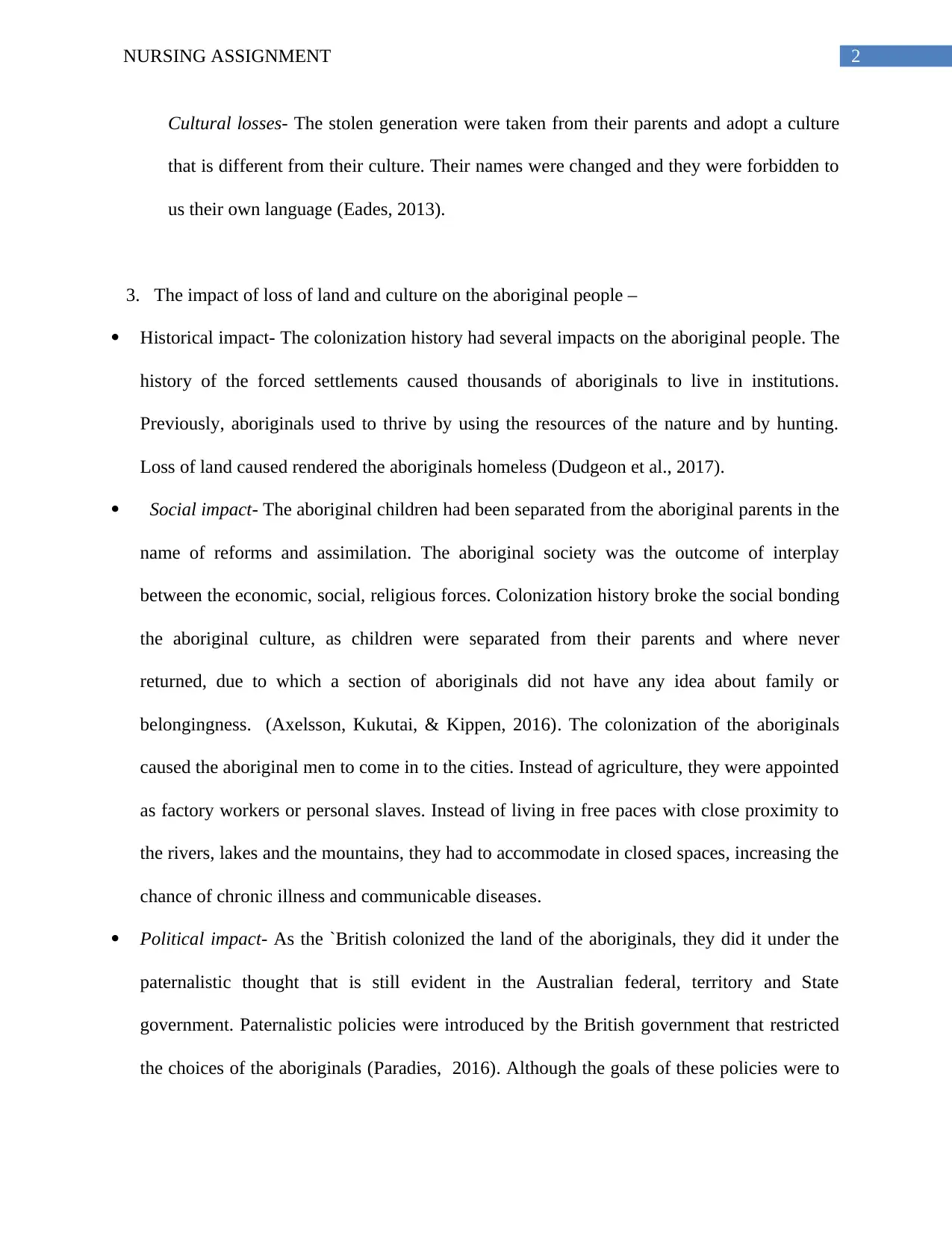
2NURSING ASSIGNMENT
Cultural losses- The stolen generation were taken from their parents and adopt a culture
that is different from their culture. Their names were changed and they were forbidden to
us their own language (Eades, 2013).
3. The impact of loss of land and culture on the aboriginal people –
Historical impact- The colonization history had several impacts on the aboriginal people. The
history of the forced settlements caused thousands of aboriginals to live in institutions.
Previously, aboriginals used to thrive by using the resources of the nature and by hunting.
Loss of land caused rendered the aboriginals homeless (Dudgeon et al., 2017).
Social impact- The aboriginal children had been separated from the aboriginal parents in the
name of reforms and assimilation. The aboriginal society was the outcome of interplay
between the economic, social, religious forces. Colonization history broke the social bonding
the aboriginal culture, as children were separated from their parents and where never
returned, due to which a section of aboriginals did not have any idea about family or
belongingness. (Axelsson, Kukutai, & Kippen, 2016). The colonization of the aboriginals
caused the aboriginal men to come in to the cities. Instead of agriculture, they were appointed
as factory workers or personal slaves. Instead of living in free paces with close proximity to
the rivers, lakes and the mountains, they had to accommodate in closed spaces, increasing the
chance of chronic illness and communicable diseases.
Political impact- As the `British colonized the land of the aboriginals, they did it under the
paternalistic thought that is still evident in the Australian federal, territory and State
government. Paternalistic policies were introduced by the British government that restricted
the choices of the aboriginals (Paradies, 2016). Although the goals of these policies were to
Cultural losses- The stolen generation were taken from their parents and adopt a culture
that is different from their culture. Their names were changed and they were forbidden to
us their own language (Eades, 2013).
3. The impact of loss of land and culture on the aboriginal people –
Historical impact- The colonization history had several impacts on the aboriginal people. The
history of the forced settlements caused thousands of aboriginals to live in institutions.
Previously, aboriginals used to thrive by using the resources of the nature and by hunting.
Loss of land caused rendered the aboriginals homeless (Dudgeon et al., 2017).
Social impact- The aboriginal children had been separated from the aboriginal parents in the
name of reforms and assimilation. The aboriginal society was the outcome of interplay
between the economic, social, religious forces. Colonization history broke the social bonding
the aboriginal culture, as children were separated from their parents and where never
returned, due to which a section of aboriginals did not have any idea about family or
belongingness. (Axelsson, Kukutai, & Kippen, 2016). The colonization of the aboriginals
caused the aboriginal men to come in to the cities. Instead of agriculture, they were appointed
as factory workers or personal slaves. Instead of living in free paces with close proximity to
the rivers, lakes and the mountains, they had to accommodate in closed spaces, increasing the
chance of chronic illness and communicable diseases.
Political impact- As the `British colonized the land of the aboriginals, they did it under the
paternalistic thought that is still evident in the Australian federal, territory and State
government. Paternalistic policies were introduced by the British government that restricted
the choices of the aboriginals (Paradies, 2016). Although the goals of these policies were to
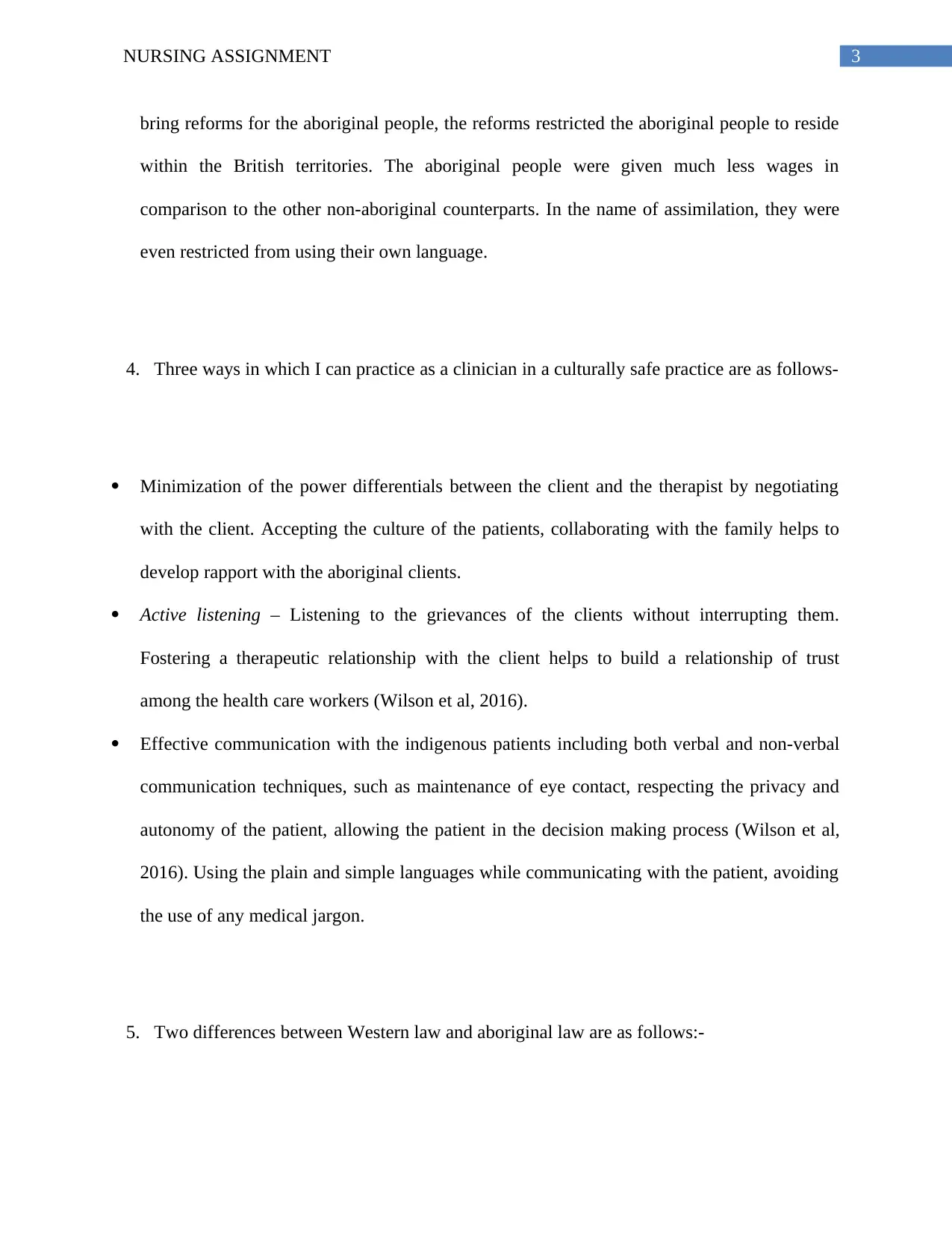
3NURSING ASSIGNMENT
bring reforms for the aboriginal people, the reforms restricted the aboriginal people to reside
within the British territories. The aboriginal people were given much less wages in
comparison to the other non-aboriginal counterparts. In the name of assimilation, they were
even restricted from using their own language.
4. Three ways in which I can practice as a clinician in a culturally safe practice are as follows-
Minimization of the power differentials between the client and the therapist by negotiating
with the client. Accepting the culture of the patients, collaborating with the family helps to
develop rapport with the aboriginal clients.
Active listening – Listening to the grievances of the clients without interrupting them.
Fostering a therapeutic relationship with the client helps to build a relationship of trust
among the health care workers (Wilson et al, 2016).
Effective communication with the indigenous patients including both verbal and non-verbal
communication techniques, such as maintenance of eye contact, respecting the privacy and
autonomy of the patient, allowing the patient in the decision making process (Wilson et al,
2016). Using the plain and simple languages while communicating with the patient, avoiding
the use of any medical jargon.
5. Two differences between Western law and aboriginal law are as follows:-
bring reforms for the aboriginal people, the reforms restricted the aboriginal people to reside
within the British territories. The aboriginal people were given much less wages in
comparison to the other non-aboriginal counterparts. In the name of assimilation, they were
even restricted from using their own language.
4. Three ways in which I can practice as a clinician in a culturally safe practice are as follows-
Minimization of the power differentials between the client and the therapist by negotiating
with the client. Accepting the culture of the patients, collaborating with the family helps to
develop rapport with the aboriginal clients.
Active listening – Listening to the grievances of the clients without interrupting them.
Fostering a therapeutic relationship with the client helps to build a relationship of trust
among the health care workers (Wilson et al, 2016).
Effective communication with the indigenous patients including both verbal and non-verbal
communication techniques, such as maintenance of eye contact, respecting the privacy and
autonomy of the patient, allowing the patient in the decision making process (Wilson et al,
2016). Using the plain and simple languages while communicating with the patient, avoiding
the use of any medical jargon.
5. Two differences between Western law and aboriginal law are as follows:-
Secure Best Marks with AI Grader
Need help grading? Try our AI Grader for instant feedback on your assignments.
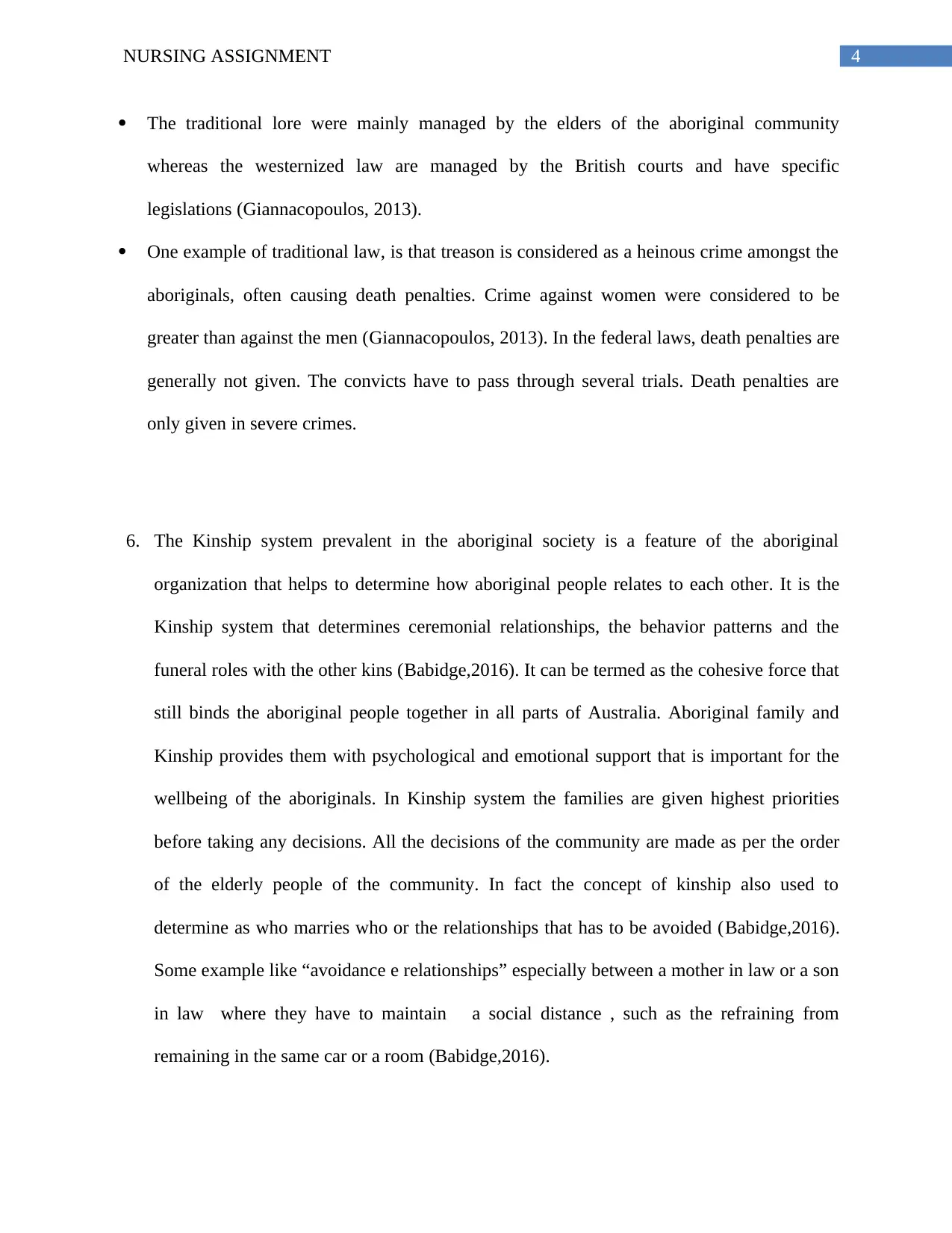
4NURSING ASSIGNMENT
The traditional lore were mainly managed by the elders of the aboriginal community
whereas the westernized law are managed by the British courts and have specific
legislations (Giannacopoulos, 2013).
One example of traditional law, is that treason is considered as a heinous crime amongst the
aboriginals, often causing death penalties. Crime against women were considered to be
greater than against the men (Giannacopoulos, 2013). In the federal laws, death penalties are
generally not given. The convicts have to pass through several trials. Death penalties are
only given in severe crimes.
6. The Kinship system prevalent in the aboriginal society is a feature of the aboriginal
organization that helps to determine how aboriginal people relates to each other. It is the
Kinship system that determines ceremonial relationships, the behavior patterns and the
funeral roles with the other kins (Babidge,2016). It can be termed as the cohesive force that
still binds the aboriginal people together in all parts of Australia. Aboriginal family and
Kinship provides them with psychological and emotional support that is important for the
wellbeing of the aboriginals. In Kinship system the families are given highest priorities
before taking any decisions. All the decisions of the community are made as per the order
of the elderly people of the community. In fact the concept of kinship also used to
determine as who marries who or the relationships that has to be avoided (Babidge,2016).
Some example like “avoidance e relationships” especially between a mother in law or a son
in law where they have to maintain a social distance , such as the refraining from
remaining in the same car or a room (Babidge,2016).
The traditional lore were mainly managed by the elders of the aboriginal community
whereas the westernized law are managed by the British courts and have specific
legislations (Giannacopoulos, 2013).
One example of traditional law, is that treason is considered as a heinous crime amongst the
aboriginals, often causing death penalties. Crime against women were considered to be
greater than against the men (Giannacopoulos, 2013). In the federal laws, death penalties are
generally not given. The convicts have to pass through several trials. Death penalties are
only given in severe crimes.
6. The Kinship system prevalent in the aboriginal society is a feature of the aboriginal
organization that helps to determine how aboriginal people relates to each other. It is the
Kinship system that determines ceremonial relationships, the behavior patterns and the
funeral roles with the other kins (Babidge,2016). It can be termed as the cohesive force that
still binds the aboriginal people together in all parts of Australia. Aboriginal family and
Kinship provides them with psychological and emotional support that is important for the
wellbeing of the aboriginals. In Kinship system the families are given highest priorities
before taking any decisions. All the decisions of the community are made as per the order
of the elderly people of the community. In fact the concept of kinship also used to
determine as who marries who or the relationships that has to be avoided (Babidge,2016).
Some example like “avoidance e relationships” especially between a mother in law or a son
in law where they have to maintain a social distance , such as the refraining from
remaining in the same car or a room (Babidge,2016).

5NURSING ASSIGNMENT
References
Axelsson, P., Kukutai, T., & Kippen, R. (2016). The field of Indigenous health and the role of
colonisation and history. Journal of Population Research, 33(1), 1-7.
Babidge, S. (2016). Aboriginal family and the state: the conditions of history. Routledge.
Dudgeon, W., Wright, M., Paradies, Y., Garvey, D., & Walker, I. (2014). Aboriginal social,
cultural and historical contexts. In Working together: Aboriginal and Torres Strait
Islander mental health and wellbeing principles and practice (pp. 3-24). Commonwealth
Department of Health.
Eades, D. (2013). They don't speak an Aboriginal language, or do they?. Aboriginal ways of
using English, 56.
Giannacopoulos, M. (2013). Offshore hospitality: Law, asylum and colonisation. Law Text
Culture, 17, 163.
Paradies, Y. (2016). Colonisation, racism and indigenous health. Journal of Population
Research, 33(1), 83-96.
Waldram, J. B. (2014). Healing history? Aboriginal healing, historical trauma, and personal
responsibility. Transcultural Psychiatry, 51(3), 370-386.
Wilson, A. M., Magarey, A. M., Jones, M., O'Donnell, K., & Kelly, J. (2015). Attitudes and
characteristics of health professionals working in Aboriginal health. Rural & Remote
Health, 15(1).
References
Axelsson, P., Kukutai, T., & Kippen, R. (2016). The field of Indigenous health and the role of
colonisation and history. Journal of Population Research, 33(1), 1-7.
Babidge, S. (2016). Aboriginal family and the state: the conditions of history. Routledge.
Dudgeon, W., Wright, M., Paradies, Y., Garvey, D., & Walker, I. (2014). Aboriginal social,
cultural and historical contexts. In Working together: Aboriginal and Torres Strait
Islander mental health and wellbeing principles and practice (pp. 3-24). Commonwealth
Department of Health.
Eades, D. (2013). They don't speak an Aboriginal language, or do they?. Aboriginal ways of
using English, 56.
Giannacopoulos, M. (2013). Offshore hospitality: Law, asylum and colonisation. Law Text
Culture, 17, 163.
Paradies, Y. (2016). Colonisation, racism and indigenous health. Journal of Population
Research, 33(1), 83-96.
Waldram, J. B. (2014). Healing history? Aboriginal healing, historical trauma, and personal
responsibility. Transcultural Psychiatry, 51(3), 370-386.
Wilson, A. M., Magarey, A. M., Jones, M., O'Donnell, K., & Kelly, J. (2015). Attitudes and
characteristics of health professionals working in Aboriginal health. Rural & Remote
Health, 15(1).
1 out of 6
Related Documents
Your All-in-One AI-Powered Toolkit for Academic Success.
+13062052269
info@desklib.com
Available 24*7 on WhatsApp / Email
![[object Object]](/_next/static/media/star-bottom.7253800d.svg)
Unlock your academic potential
© 2024 | Zucol Services PVT LTD | All rights reserved.





